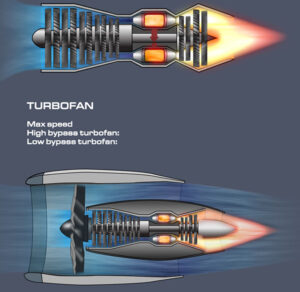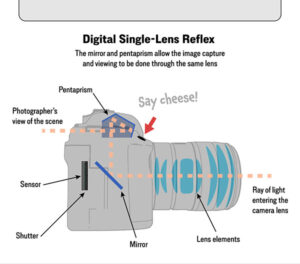In the 1950s, the newly formed NASA needed a very large rocket engine – enter the Rocketdyne F-1. The F-1 became a show of power both literally and figuratively during the cold war. NASA used it in its early space missions, including Apollo XI, humankind’s first trip to the moon.
The F-1 is the largest single nozzle rocket engine in history. It produced 6.8MN (1,522,000 lbf) of thrust at sea level. This is almost four times that of the RS-25, the Space Shuttle’s main engines. For a more worldly comparison, the engines on a Boeing 747 each produce around 0.25MN of thrust.
To give you some idea of what they could do, five F-1 engines drove the Saturn V rocket to a speed of 9,920 km/h (6,164 mph) in two and a half minutes!
Only the Russian made RD-170 engine produced more thrust than the F-1. The RD-170, however, used a multi-nozzle and combustion chamber design.
The basics of rocket engine function
Rocket engines use a controlled explosion to provide thrust. A more formal term for this explosion is combustion.
Combustion is what you get when fuel and oxygen react with each other. The result is a violent expansion of gases and heat. Directing these gases in a certain direction creates thrust in the opposite direction – as per Newton’s third law.
Unlike jet engines, which take in oxygen from the air, rocket engines use oxygen carried onboard along with the fuel. This allows rocket engines to be much more powerful, albeit with some extra challenges. For one, oxygen needs to be kept in the liquid state for a rocket to carry enough of it. And making liquid oxygen (LOX), requires cryogenic cooling to low temperatures, as it has a boiling point of -183°C (-297°F).
How the F-1 engine works: the gas generator cycle
There are a few variations in rocket engine design. The F-1 used the gas generator cycle.
With the gas generator cycle, some fuel and LOX is diverted away from the combustion chamber and towards the gas generator. Here, a smaller amount of combustion occurs to drive a turbine. This turbine then powers two turbopumps – the fuel turbopump, and the LOX turbopump. These turbopumps feed the main combustion chamber with fuel and LOX.
The gas generator cycle is an open rocket engine design. This means the engine expels the exhaust gases from the gas generator without it contributing to the main combustion. A closed system, on the other hand, does not have a separate exhaust system for the turbine combustion.
How the F-1 produces so much thrust
The F-1 engine’s turbine has a power output of 41MW. This is 41 times more powerful than the fastest production car in the world, the Koenigsegg Agera. And this power is just pumping the fuel – it’s not even the main event.
With the amazing turbopump power, the F-1 consumes 788 kg/s (1,738 lb/s) of RP-1 fuel and 1,789kg/s (3,945 lb/s) of LOX! Because combustion power grows with propellant flow rate, the F-1 achieves its mighty levels of thrust through its ravenous consumption of fuel.
With this thrust also comes heat. To keep the nozzle from melting, the RP-1 fuel has a secondary mission. It absorbs heat from the nozzle as it passes through a void prior to reaching the combustion chamber. In doing so, the fuel is heated, and the nozzle is cooled, which prevents it from reaching critical temperatures.
Ok so it made lots of thrust, but how powerful was the F-1?
You’re probably thinking, “this sounds impressive, but how much horsepower did the F-1 produce?” After all, it would be good to scale it against things we are familiar with, like a car engine.
If you do any research on rocket engines, you will find that power figures are not common. This is because power, the rate at which work can be done, is not a useful performance metric for rocket engines.
To explain why, first consider a rocket engine flying through space without any restriction. The rocket will travel fast and the work done in any stretch of time will be significant, as work = thrust x distance.
Then consider the same rocket engine, but this time, having it held in place by a test rig. Even if the same thrust is provided, the fact that the engine isn’t moving means that its motive power, in this case, is zero.
So this shows the “power” a rocket engine displays depends on the restrictions placed on the rocket.
In comparison, car engine power will closely match the motive power of the car. Hence why engine power is a useful performance metric for cars. This is unless the wheels lose traction and spin without the car moving. Perhaps car burnouts are a good analogy for rocket engines – in both cases, the engine power and motive power of the vehicals are not equal.
Thrust, which is force, is a better metric for rocket engines as it explains how the rocket can overcome resistance, like breaking out of Earth’s gravitational pull.
Calculating the power output of the F-1 rocket engine
Calculating rocket engine power exactly is tricky to do. There’s a lot of complexity and efficiency losses that are hard to quantify. But we can come up with a ballpark figure by multiplying the RP-1 burn rate with its heat of combustion, or more specifically, its Lower Heating Value (LHV). This gives the chemical power of combustion which we can then adjust with engine efficiency to give the rocket engine’s propulsive power.
LHV is the amount of energy that is released through fuel combustion. As opposed to Higher Heating Value (HHV), LHV considers the water that is made through combustion to be in vapor form, not liquid.
The chemical power of combustion calculation is as follows:
RP-1 burn rate: 788 kg/s
RP-1 LHV: 44 MJ/kg
Power = 788 x 44 = 34,672 MJ/s = 34,672 MW
Rocket engines have a peak efficiency of around 70%. This means that 70% of the chemical energy released is transferred into rocket kinetic energy. So making this adjustment we get the following:
Power = 34,672 x 0.7 = 24,270 MW = 24 Gigawatts
Then to convert to horsepower:
Horsepower = 24 x 1,341,022 = 32,184,528 hp
As the Saturn V rocket had five F-1 engines, its total power was around 160 million horsepower, or 120 gigawatts. For perspective, this is roughly equal to the entire electricity generating capacity of Spain!
The F-1's legacy and current rocket engine designs
The R-1 belongs in the engineering hall of fame. Its design overcame incredible challenges to achieve things the world had never seen before. And in some ways, will probably never see again.
Modern rocket engine designs are smaller and less powerful. This is to find a balance with other requirements aside from thrust. Many new designs, like the SpaceX Raptor engine, consider reusability and cost per flight to make space launches more economical. This was not part of the equation when NASA was given a blank check for the Apollo program.
Another reason we won’t see anything like the F-1 again is the craftsmanship it needed to make. Back in the 1950s, hands-on skill ensured the final product was up to the task. Today, advanced manufacturing has replaced manual labour, and in the process we have lost the intricate know-how of the F-1’s construction. Something of a similar spec built today, will look pretty different.
It’s not unreasonable to expect humanity’s future lies among the stars. To what extent, it’s hard to know. But without doubt, the Rocketdyne F-1 paved the first steps in that direction.


